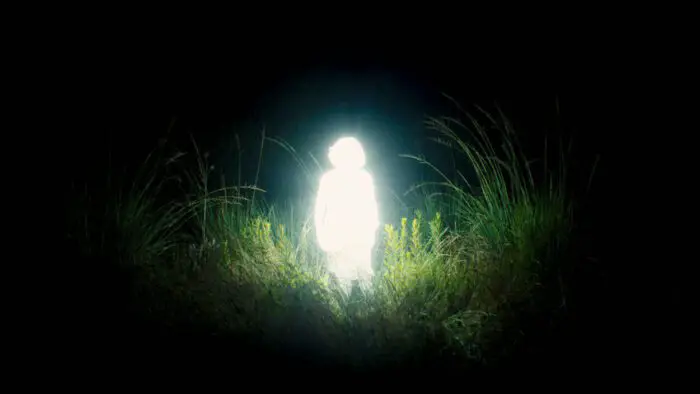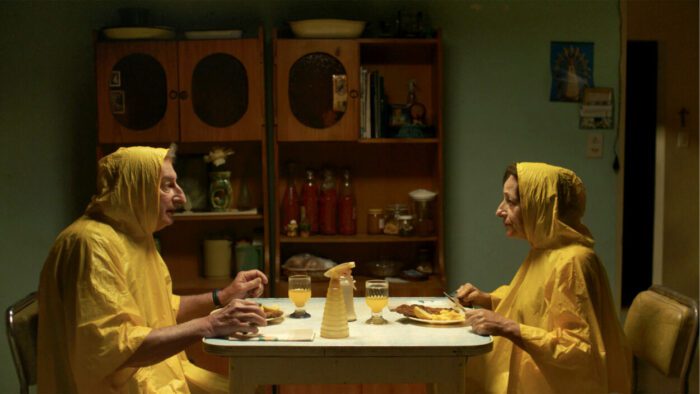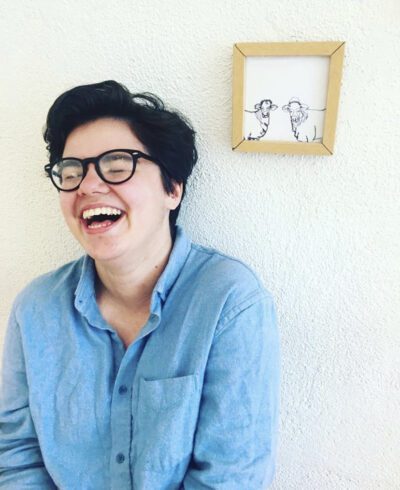In 2023, Chronicles of a Wandering Saint premiered at SXSW to rave reviews that would lead to three Independent Spirit Award nominations. The film takes place in a rural town in Argentina where Rita (Mónica Villa), a devout woman, is planning to ensure she will make it to heaven. Her plan? Stage a miracle so great that she will be granted sainthood. What sounds like a charmingly quirky premise turns into something deeper that asks the audience to think about what constitutes as a miracle. In the hands of writer/director Tomás Gómez Bustillo, Chronicles of a Wandering Saint transcends its small town to look at the greater mysteries of the universe through a bizarrely lyrical lens.
Gómez Bustillo grew up across Argentina, El Salvador, Costa Rica, and the United States. In Buenos Aires, he received a degree in Political Science and then moved to Los Angeles. There, he earned an MFA in Directing from the American Film Institute Conservatory. Gómez Bustillo sat down with Film Obsessive News Editor Tina Kakadelis to chat about his feature film debut, Chronicles of a Wandering Saint. The transcript has been edited for clarity and space.
Film Obsessive: I wanted to first ask about miracles and unexplained things because it’s a huge theme in Chronicles of a Wandering Saint. I also saw your short film, The Museum of Fleeting Wonders, and it’s also a big theme in that. What is your personal definition of a miracle? And do you think that miracles can be bad?
Tomás Gómez Bustillo: Wow. That’s. Man, you’re putting…I mean, that’s a tough spot.
The questions get easier!
I think a miracle is…I mean, please never…Well, you can definitely quote me on this because that’s what we’re doing in this interview. [laughs] But, a miracle is a complete reversal of what is expected. Something that just kind of like, jolts you awake to the uncertain nature of the universe. You think everything is going to go one way, and then what a miracle does is it kind of slaps in the face and reminds you that it could go anywhere at any moment. I don’t know that I would say that miracles would or could be bad because maybe we would use a different word. More of an accident or a freak accident or something like that. But then again, it’s like, why? Why even they say that things are bad or good in the first place? I hope that’s not an absolutely terrible answer, but that’s the best I could come up with at this moment.
No, that’s great! It’s very interesting because it’s clearly something that like has returned to you in terms of themes.
I mean, how would you how would you define miracle? Now I get to turn the table on you!
I don’t think that there are bad miracles because I feel like inherently there is something positive about a miracle, even if it’s not immediately obvious that there’s a positive effect. I think I would define a miracle, though, as something like you said. It’s a forcible turn in your life that you probably wouldn’t have taken on your own. Which is why it makes sense in Chronicles of Wandering Saint that her miracle goes wrong because she’s trying to force it. It’s like a round peg in a square hole, you know?
Exactly, yeah. It’s like it’s not up to you. It’s not within your agency. And that’s really great.
Where did the inspiration come from for this particular story?
The story didn’t just like come to my mind. It was really a process of layering multiple different ideas and sources of inspiration. I think the initial image that popped into my mind while I was listening to music was of a person who was completely made of light. This person was wandering around a dark space and even though they looked beautiful, they felt lonely at the same time. That was something that drew me in from the very beginning. And then, I worked really hard to develop that into a story. Okay, so who is this person and why are they like this? Why do they feel lonely? And that’s kind of the the origin story of this story.

It’s funny that the origin kind of comes from an image of light because my next question is about the lighting in the movie. The glowing figure makes an appearance at the end, but then you also have this scene that takes place during the storm where it’s flashes of lightning that’s just stunning. I wanted to know if you could talk a little bit about how you see light or the absence of light as a tool in terms of your storytelling.
Honestly, I would probably say that light is kind of the biggest tool we have. As filmmakers, if there was no light, there would be no movie. You could say that without a character, there could still be a movie. There could still be a movie without a plot. There’s still be a movie without, a number of other things. But light is kind of what film is made out of in the first place. It’s the very thing it’s made out of. I think light and dark are the DNA of film. I’ve always been obsessed with light and dark. My mother is a painter. I grew up around books that talked about chiaroscuro or all these different techniques to render light in a specific effect. I always found that really fascinating.
In film particularly, I remember seeing Apocalypse Now for the first time when I was like sixteen. My dad showed it to me and it blew my mind. There’s a sequence where he’s going through the bridge. There’s just this endless searchlight going around and around. I think a lot of that lightning sequence owes itself to that reference because it blew my mind so much. I had never seen how editing and light could work together like that.
That’s a great scene and great use of light. Your film is a little unusual in the sense that the full credits of the movie play at around the midpoint. I was hoping you could talk a little bit about why you chose to do it there and then also the song because the song is an incredible song choice.
I love that song too. The idea of having the credits in the middle of the movie were there from the very first draft. The way my mind works is I’m usually drawn to can I get away with this. The morbid curiosity of doing something differently rather than doing something really, really well is what excites me more. I was like, could I put the credits in the movie and somehow make it work. To not just put them there because anybody could put them there, but to make them feel like a necessary part of the film. That was something that really, really excited me. Obviously being a first time filmmaker, I had no reputation on the line. Nothing to risk, so might as well give it a shot. The thing that I had to work extra hard on was to make it feel like part of a movie and not like a gimmick.
It was really trying to make the credits mimic the experience of the character in that moment. The audience is kind of placed in the exact kind of shock state that she would be after what had just happened to her.

And was the song there from the beginning? This EDM remix of Bryan Adams’ “Heaven.”
Actually, I went through a bunch of different songs and that one was always an option. I wouldn’t really know until we tried it with the footage, you know? And then as soon as we try that song with the footage was it was like magic. I had heard that song a lot as a teenager sneaking into clubs in Buenos Aires. It was a really huge hit back then. The added bonus is that it also references an even older song that is a beautiful love ballad. It worked on a lot of thematic levels. It refers to a lost era of of lost love. It always felt like a really layered, choice that that song which is why I thought it could work.
At some of the screenings that you’ve been to, did anyone think that the movie was genuinely over at the credits?
A lot of people did! We always would ask the theater managers to not turn the lights on. I think that was the key because 99% of people who were there knew they were watching a feature film, not a short film. So at some point when the credits come on, they start talking with each other and they look at their phones. They’re like, it can’t be, this is so weird. You see their confusion. It’s so fun to watch. I’m just secretly hiding and watching them. It’s really exciting to them. I’ve seen a couple of people half get up, take one step, and look over their shoulders. Like, should I leave or should I not leave? Everybody feels like it shouldn’t be over. That’s a really cool feeling because I feel like it ends up engaging them more as an audience member when their suspicion is confirmed. They were part of the trick and not outside of it.
You mentioned that this was your first feature and I just wanted to know if there was any major difference between switching from shorts to features that surprised you that you hadn’t anticipated when you made this one?
I think the biggest difference between making a short and making a feature is that a feature requires multiple tones and multiple layers. Usually, you should make a short out of one beat, one moment, one good tone. For a feature to become interesting and dynamic, you really have to flow. You have to tighten it up and release. You have to go a little bit funnier and then more contemplative. You need to give people the space to breathe, to get agitated and then to come back down. I think molding that audience experience is a really difficult thing. It took a lot of drafts to figure that out. It was like a new medium almost.
Some of the actors in the movie were also first time actors, right? I think you’ve worked with them before in the Museum of Fleeting Wonders, so it’s not an unfamiliar territory for you.
Yeah, of the actors in Museum, there’s a couple who were professional actors, but I would say 70% of them were non non-actors. Originally, I thought that I was going to make Chronicles with a completely non-actor cast. At some point, I think understanding the limitations of our of our prep schedule and our budget, it became clear that we needed trained actors because they will require less prep. You have to build an infrastructure around non-actors. There’s a big difference between a short and a feature. I could definitely work with non-actors in a short because it’s kind of quick and painless. On a feature, they need stamina, right? You need to be able to work with this person for 30 days and multiple takes every day, 12 hours a day.

There’s been a recent trend in movies that are more horror-focused than yours, that are ghost stories, but also love stories. Chronicles isn’t a horror, but I’d say that it also kind of fits that bill. Could talk about what you think it is about the dead and ghosts that can influence the living?
I mean, at the end of the day, that’s just life, right? The only thing we know for certain is that we’re all going to die. That even the people that we love are going to die. I think if you don’t have this anxiety or this concern or even just this thought, then you’re probably just escaping it. So many of us lose somebody or almost lose somebody, and then only then do things come into perspective. Like, what your true feelings were about about that person. I think that’s where ghost stories kind of give people a cathartic way to explore that territory. Where it’s like, well, if I lost this person and I was still around to somehow see how they were and what they really felt about me, it’s like an exercise of the sort that you need to think about in order to maybe, hopefully, straighten out your feelings, emotions, and priorities around those relationships.
My last question is related to a small spoiler in the movie where some people who miss their mark to ascend become inanimate objects. I was wondering if you had to be an inanimate object, which one would you choose to end up as?
That’s a great question and I don’t think anybody’s asked it to me. I was thinking about this when writing the movie and I was like, man, what would be really cool? I do think probably I would be the person who was stuck in the breeze. I thought this was a really cool place to be stuck in. Not the wind, but a single breeze. It would be like you’re always on tour. You just keep seeing all the sights and you meet new people and sometimes there’s no wind, so you kind of just hang out and make friends. Then the breeze takes you all over again and you never know where you’ll end up. That kind of keeps it interesting. I think I would rather do that and be stuck in like a single place for all of eternity, you know? What about you?
I was thinking about it earlier when I was making these questions. I was thinking like a tennis racket because I love playing tennis, but then I thought about it twice. How many people throw their racquets dramatically? I think that sounds miserable. A dog seems really nice. Especially if I could get like someone who just carries a dog around in a fancy bag.
A dog’s life is not a bad life to have, but not everybody treats things nicely the way you do. Some people are not nice to their dogs and some people smash their racquets or worse still, I have a couple of friends like who are major tennis player, but then they moved and then they left their racquet in the garage. You would become this lonely racquet just peering out of the single crack in that garage being like, one day, one day I’ll get to play again, you know?
And then it’s a Pixar movie. I think you’re onto something, though, by choosing the wind or the ocean. Or maybe something like stardust.
That would be a really good idea, actually. I’m going to use that one if anybody asks me ever again.
Space is like where everyone’s going next, so I won’t be lonely unless I end up in a black hole.
But then you’ll probably discover the secrets of the universe!
That’s true! All right, that’s all the questions that I have. Thank you so much. Your film is so lovely.
Thank you. It’s been a pleasure, Tina.



